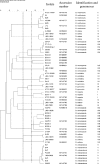Revised approach for identification of isolates within the Burkholderia cepacia complex and description of clinical isolates not assigned to any of the known genomovars
- PMID: 17626169
- PMCID: PMC2045300
- DOI: 10.1128/JCM.00976-07
Revised approach for identification of isolates within the Burkholderia cepacia complex and description of clinical isolates not assigned to any of the known genomovars
Abstract
One hundred thirty-eight clinical isolates of the Burkholderia cepacia complex (Bcc) were identified using a modified strategy that involved PCR detection of the cblA gene for the ET12 lineage simultaneously with detection of the Bcc recA PCR product; recA sequence cluster analysis also was part of the strategy. Four strains could not be assigned to any of the known genomovars.
Figures


Similar articles
-
RecA gene sequence and Multilocus Sequence Typing for species-level resolution of Burkholderia cepacia complex isolates.Lett Appl Microbiol. 2009 Nov;49(5):580-8. doi: 10.1111/j.1472-765X.2009.02709.x. Epub 2009 Aug 7. Lett Appl Microbiol. 2009. PMID: 19732325
-
Burkholderia cepacia complex epidemiology in persons with cystic fibrosis from Australia and New Zealand.Res Microbiol. 2008 Apr;159(3):194-9. doi: 10.1016/j.resmic.2008.01.001. Epub 2008 Feb 2. Res Microbiol. 2008. PMID: 18356026
-
Diversity and distribution of Burkholderia cepacia complex in the rhizosphere of rice and maize.FEMS Microbiol Lett. 2007 Jan;266(2):231-5. doi: 10.1111/j.1574-6968.2006.00530.x. FEMS Microbiol Lett. 2007. PMID: 17233735
-
Accurate identification and epidemiological characterization of Burkholderia cepacia complex: an update.Ann Clin Microbiol Antimicrob. 2019 Feb 4;18(1):7. doi: 10.1186/s12941-019-0306-0. Ann Clin Microbiol Antimicrob. 2019. PMID: 30717798 Free PMC article. Review.
-
Classification and identification of the Burkholderia cepacia complex: Past, present and future.Syst Appl Microbiol. 2011 Apr;34(2):87-95. doi: 10.1016/j.syapm.2010.10.002. Epub 2011 Jan 22. Syst Appl Microbiol. 2011. PMID: 21257278 Review.
Cited by
-
Development of a species-specific fur gene-based method for identification of the Burkholderia cepacia complex.J Clin Microbiol. 2008 Feb;46(2):447-55. doi: 10.1128/JCM.01460-07. Epub 2007 Dec 5. J Clin Microbiol. 2008. PMID: 18057135 Free PMC article.
-
Gut microbiota signatures in cystic fibrosis: Loss of host CFTR function drives the microbiota enterophenotype.PLoS One. 2018 Dec 6;13(12):e0208171. doi: 10.1371/journal.pone.0208171. eCollection 2018. PLoS One. 2018. PMID: 30521551 Free PMC article.
-
Identification of potential diagnostic markers among Burkholderia cenocepacia and B. multivorans supernatants.J Clin Microbiol. 2010 Nov;48(11):4186-92. doi: 10.1128/JCM.00577-10. Epub 2010 Sep 1. J Clin Microbiol. 2010. PMID: 20810766 Free PMC article.
-
An outbreak of Burkholderia cenocepacia bacteremia in immunocompromised oncology patients.Infection. 2010 Jun;38(3):187-94. doi: 10.1007/s15010-010-0017-0. Epub 2010 Apr 1. Infection. 2010. PMID: 20358245
-
Identification of Burkholderia cepacia strains that express a Burkholderia pseudomallei-like capsular polysaccharide.Microbiol Spectr. 2024 Mar 5;12(3):e0332123. doi: 10.1128/spectrum.03321-23. Epub 2024 Feb 1. Microbiol Spectr. 2024. PMID: 38299821 Free PMC article.
References
-
- Biddick, R., T. Spilker, A. Martin, and J. J. LiPuma. 2003. Evidence of transmission of Burkholderia cepacia, Burkholderia multivorans and Burkholderia dolosa among persons with cystic fibrosis. FEMS Microbiol. Lett. 228:57-62. - PubMed
-
- Caraher, E., C. Duff, T. Mullen, S. Mc Keon, P. Murphy, M. Callaghan, and S. McClean. 2007. Invasion and biofilm formation of Burkholderia dolosa is comparable with Burkholderia cenocepacia and Burkholderia multivorans. J. Cyst. Fibros. 6:49-56. - PubMed
-
- Chen, J. S., K. A. Witzmann, T. Spilker, R. J. Fink, and J. J. LiPuma. 2001. Endemicity and inter-city spread of Burkholderia cepacia genomovar III in cystic fibrosis. J. Pediatr. 139:643-649. - PubMed
-
- Coenye, T., E. Mahenthiralingam, D. Henry, J. J. LiPuma, S. Laevens, M. Gillis, D. P. Speert, and P. Vandamme. 2001. Burkholderia ambifaria sp. nov., a novel member of the Burkholderia cepacia complex including biocontrol and cystic fibrosis-related isolates. Int. J. Syst. Evol. Microbiol. 51:1481-1490. - PubMed
MeSH terms
Substances
Associated data
- Actions
- Actions
- Actions
- Actions
LinkOut - more resources
Full Text Sources

